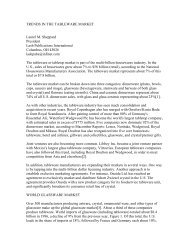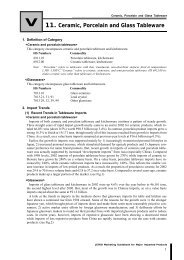Appendices to CBI Export Planner - crecer
Appendices to CBI Export Planner - crecer
Appendices to CBI Export Planner - crecer
You also want an ePaper? Increase the reach of your titles
YUMPU automatically turns print PDFs into web optimized ePapers that Google loves.
<strong>CBI</strong> <strong>Export</strong> <strong>Planner</strong>Actually, you can use the same <strong>to</strong>p-down/bot<strong>to</strong>m-up method for feasibility calculations(Chapter VI). In this case the period is usually longer (up <strong>to</strong> 3 years) since the exporterwill have <strong>to</strong> invest in a market position.The calculations for industrial goods are less complicated, since there are fewerintermediate levels between supplier and cus<strong>to</strong>mer; frequently there are none at all whensupplying directly. That does not mean that you should refrain from calculating, becauseyou should have insight in the market pricing in order <strong>to</strong> strengthen your position duringnegotiations. Never allow a cus<strong>to</strong>mer <strong>to</strong> catch you on lack of market know-how as thatweakens your bargaining power.For industrial quotations VAT can be left out, since only end-consumers pay this tax.The permanent pressure on your cost priceMost industrialized markets, particularly where demand meets saturation, know fiercecompetition. In the Single Market, on the whole prices have actually gone done withsome of 6% as a result of the liberalisation of the circulation of goods throughout itsterri<strong>to</strong>ry. That trend is universal; cross-border procurement is the rule rather than theexception.For survival, the suppliers <strong>to</strong> such markets should dedicate a lot of effort <strong>to</strong> decreasingcosts and prices. For a proper pricing several aspects require special managerialattention:a. The level of your cost-price is very important <strong>to</strong> your market price. Adding one dollar<strong>to</strong> your cost-price, means that your market-price (in the calculation example) willincrease with 4 dollars! The multiplying fac<strong>to</strong>r can be established via your “<strong>to</strong>p-downcalculation”.Therefore, you should always try <strong>to</strong> keep your costprice as low as possible. Your ISOmethodology,if certified, will help you there. Management should continuously lookfor ways <strong>to</strong> decrease their costs. Just claiming low labour costs is usually notsufficient for price-matching; don’t forget that in industrialized countries labour haslargely been replaced by au<strong>to</strong>mation, so in that respect their production costs can beas low as yours. The technique of ‘bench-marking’ (comparing your performancewith those of your nearest or strongest competi<strong>to</strong>r with the help of TQM) could helpyou out.b. Cost-cutting is nowadays an integrated element of (quality) production management,trying <strong>to</strong> make the most with less resources. Areas for possible improvement of costefficiency are:• reducing the costs of raw and half-material and of components• reducing the costs of energy and labour• increasing overall production efficiency, decrease waste, etc.Spreading production costs over a larger number of units produced, contributes <strong>to</strong> theeconomy of scale. This is the second approach <strong>to</strong> cost-efficiency. Actually, since theenlarging of the sales areas within Europe allow for such scale-economizing, manymanufacturers seek alliances <strong>to</strong> realize larger production runs, spreading the costs ofResearch and Development, procurement, maintenance and skilled labour over moreunits produced.42 III - The export marketing mix





